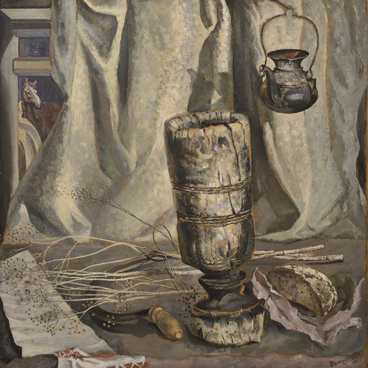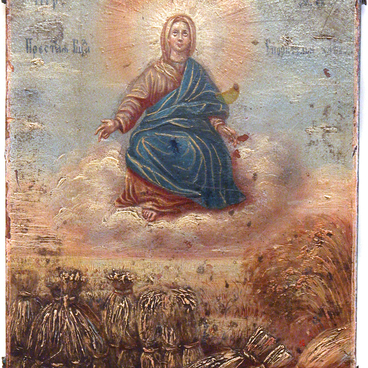Depiction of historical figures can be traced in religious art starting approximately from the 17th century. One of the first personalities put in the icon was the prince Andrey Bogolyubsky (the plot Appearance of Mother Mary to the prince Andrey Bogolyubsky). According to the rules only the person canonized by the Orthodox church could be depicted in the icon.
The icon has an image of the holy hierarch John, the metropolitan of Tobolsk and Siberia. John Maksimovich was born in 1651 in Chernigov Governorate. Since his early age he was educated in love for God and he dedicated his whole life journey to the spiritual service. Having received education in Kiev College (later to become Academy), he stayed there as a teacher. In 1676 he took the monastic vows with the name John in the Kiev Pechersk Lavra. In 1712 he became the metropolitan of Tobolsk and Siberia. As a metropolitan John did a lot for development of the Orthodox church in the Siberian eparchy. He built divinity schools, and put efforts into opening new churches. The holy hierarch left a lot of religious texts, such as preaches, monographies, poems. After his death the cases of healing the believers with his relics were registered.
In February 1916 the decision of Synod about his All-Russian glorifying was made, and soon the capital and local icon workshops started to create John’s images. This icon is one of such images.
The artifact is interesting as an example of icon painting from the Ural Siberian region and was painted by a local icon painter from Kurgan region for one of the churches. Considering the length of the icon, which is 170 cm, it could’ve had a central place in the side-altar dedicated to the metropolitan.
The icon was created in 1916, which was a very complicated time for Russia with its growing civil disturbances and World War I. In this period a great number of icons of Metropolitan John was created along with construction of the churches dedicated to him. The celebrations took place in the whole region, the believers applied to the saint with prayers about the fast termination of war.
The holy hierarch’s iconography is of special interest. The image was painted during the reign of art nouveau style in art. As the most traditional and canonic area, icon painting wasn’t critically influenced by it, however, it took some of its stylistic features. The holy hierarch was painted against the golden carved background, which makes the icon look extremely ceremonial and doesn’t distract from the figure. Proportions were shown in the parallel, and not inverted perspective. The image itself is very humane, it has softness and doesn’t look ascetic and detached. The image of a smooth earth whereto the depicted character is placed is a distinctive feature of the modernist icons. In some cases, like in this one, it imitates tiles. In the palette. except for the prevailing golden and blue tones. one can see the smooth shades of silver, green, and coral.
The icon has an image of the holy hierarch John, the metropolitan of Tobolsk and Siberia. John Maksimovich was born in 1651 in Chernigov Governorate. Since his early age he was educated in love for God and he dedicated his whole life journey to the spiritual service. Having received education in Kiev College (later to become Academy), he stayed there as a teacher. In 1676 he took the monastic vows with the name John in the Kiev Pechersk Lavra. In 1712 he became the metropolitan of Tobolsk and Siberia. As a metropolitan John did a lot for development of the Orthodox church in the Siberian eparchy. He built divinity schools, and put efforts into opening new churches. The holy hierarch left a lot of religious texts, such as preaches, monographies, poems. After his death the cases of healing the believers with his relics were registered.
In February 1916 the decision of Synod about his All-Russian glorifying was made, and soon the capital and local icon workshops started to create John’s images. This icon is one of such images.
The artifact is interesting as an example of icon painting from the Ural Siberian region and was painted by a local icon painter from Kurgan region for one of the churches. Considering the length of the icon, which is 170 cm, it could’ve had a central place in the side-altar dedicated to the metropolitan.
The icon was created in 1916, which was a very complicated time for Russia with its growing civil disturbances and World War I. In this period a great number of icons of Metropolitan John was created along with construction of the churches dedicated to him. The celebrations took place in the whole region, the believers applied to the saint with prayers about the fast termination of war.
The holy hierarch’s iconography is of special interest. The image was painted during the reign of art nouveau style in art. As the most traditional and canonic area, icon painting wasn’t critically influenced by it, however, it took some of its stylistic features. The holy hierarch was painted against the golden carved background, which makes the icon look extremely ceremonial and doesn’t distract from the figure. Proportions were shown in the parallel, and not inverted perspective. The image itself is very humane, it has softness and doesn’t look ascetic and detached. The image of a smooth earth whereto the depicted character is placed is a distinctive feature of the modernist icons. In some cases, like in this one, it imitates tiles. In the palette. except for the prevailing golden and blue tones. one can see the smooth shades of silver, green, and coral.



